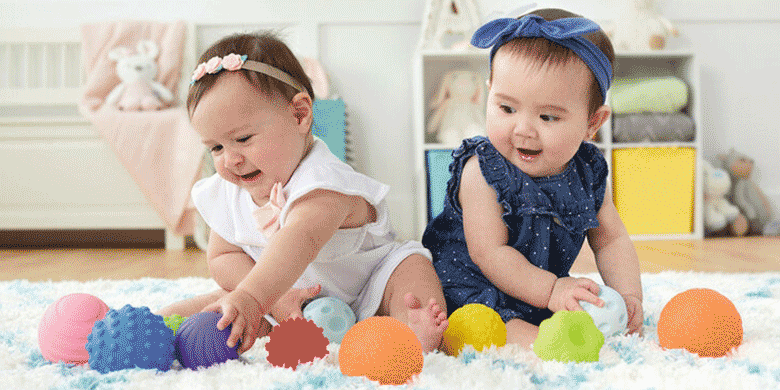
14 February, 2024
Stress Shapes for Children: A Tool for Calmer Minds and Better Focus
In an increasingly complex world where children are exposed to numerous stressors - be it academic pressures or emotional challenges - it's more important than ever to find effective tools for managing stress and improving focus. One such tool that's often overlooked is the stress shape. These tactile objects offer numerous benefits for children's mental well-being. We'll discuss why custom stress shapes are not merely toys but crucial aids for calmer minds and better focus.
The Importance of Sensory Stimulation
1) Developmental Significance of Tactile Stimulation
The somatosensory system, responsible for our sense of touch, is one of the first to develop in human beings. It starts functioning while the foetus is still in the womb. As newborns and throughout childhood, tactile stimuli are critical to experiential learning, facilitating key developmental milestones. For instance, through touch, infants begin to form mental maps of their bodies and the world around them, aiding spatial awareness. Likewise, tactile experiences play a fundamental role in developing fine and gross motor skills, such as grasping, which later evolve into more complex capabilities like handwriting.
2) Cognitive Benefits
Moreover, tactile stimulation has been shown to boost cognitive functions, including attention and memory. There are multiple neurophysiological reasons for this. When you engage with tactile objects, you activate neural pathways associated with focus and concentration. It can help channel mental resources towards cognitive tasks requiring sustained attention. This translates into better academic performance and enhanced problem-solving and critical-thinking skills for children.
3) Emotional Regulation and Mindfulness
From an emotional and psychological perspective, tactile stimuli can indeed serve as an effective method for emotion regulation. The sensory experience can trigger the release of neurotransmitters such as dopamine and serotonin, which are key players in mood regulation. Additionally, focused tactile engagement promotes mindfulness. In this context, mindfulness refers to the state of being completely present and fully engaging with the here and now. This is particularly valuable for children who are learning to regulate their emotions and reactions to external stimuli.
The Role of Stress Shapes
Stress shapes are an excellent conduit for delivering these benefits of tactile stimulation. They are safe, portable, and can be used in various settings—be it at home, in school, or even in therapeutic settings. The act of squeezing a stress shape necessitates a form of muscular engagement and focused attention that provides immediate sensory input. This satisfies the need for tactile engagement, which, as discussed, can have cascading benefits for cognitive function and emotional well-being.
The sense of touch isn't merely a peripheral aspect of human development; it's central to how children learn, focus, and emotionally mature. In their seemingly simplistic design, stress shapes offer a surprisingly effective way to tap into these developmental pathways. They embody a confluence of psychological, neurobiological, and educational benefits that can assist children in navigating the complexities of growth and learning.
Types of Stress Shapes

Stress shapes come in various forms, sizes, and materials. Some are filled with gel, foam, or even beads. The outer layer can range from rubber to fabric, each offering a different sensory experience. There are also shapes designed for children with special needs, such as textured or weighted variants, adding another layer of customisability to this valuable tool.
- Gel-Filled Stress Shapes
These offer a unique, squishy texture that can be particularly engaging for children. The gel's resistance helps strengthen the small muscles in the hands and fingers, thereby aiding fine motor development. Moreover, the tactile sensation provided by these shapes can have a calming effect on the child’s nervous system, making them particularly useful in scenarios that require emotional regulation, such as managing anxiety or impulsivity.
- Foam-Filled Stress Shapes
Foam-filled shapes are generally lighter and offer less resistance than their gel-filled counterparts. These are great for younger children who might not yet have the hand strength to manipulate denser materials. Foam shapes are also more easily squeezable, providing immediate tactile feedback that can relieve momentary stress.
- Bead-Filled Stress Shapes
Bead-filled shapes offer a multi-faceted sensory experience. As the beads move within the encasement, they provide both auditory and tactile stimuli. This can be particularly beneficial for children with Attention-Deficit/Hyperactivity Disorder (ADHD) or sensory processing issues, as multi-sensory engagement can help in focusing attention.
- Rubber Vs. Fabric Outer Layer
The material of the outer layer is also crucial in determining the sensory experience. Rubber is smooth and offers a consistent texture, whereas fabric can offer a softer, varied tactile experience. The choice between these depends on individual sensory preferences and can be particularly significant for children with tactile sensitivities.
- Textured Stress Shapes
Textured ones come with different surfaces—bumps, ridges, or even soft spikes—that add an additional layer of tactile stimulation. This can be highly beneficial for children with sensory processing disorders, as it helps them become more accustomed to a variety of textures, thereby aiding in sensory integration therapy.
- Weighted Stress Shapes
Weighted stress shapes offer the benefits of deep pressure therapy. The added weight can help ground the child, thereby reducing anxiety and inducing a calm state. These are often used in therapeutic settings for children with autism spectrum disorders or other sensory issues.
- Special Shapes and Characters
It's also worth noting that stress shapes are available in various fun designs like animals, objects, or even cartoon characters, which can be highly appealing to children. This visual element can serve to further engage the child’s attention, making the stress shape even more effective as a calming tool.
Psychological Advantages
1) Emotional Regulation
Stress shapes can serve as a tangible point of focus when emotions run high, providing an outlet for nervous or kinetic energy. Squeezing can serve as a somatosensory cue, helping activate the parasympathetic nervous system, which is responsible for calming the body. Their tactile nature can also help children articulate their emotional states better, offering them a non-verbal way to express tension or discomfort. From a cognitive-behavioural standpoint, teaching children to reach for one when they start to feel overwhelmed can help them build healthier coping mechanisms for emotional regulation.
2) Improved Concentration
From the perspective of child psychology, the proprioceptive input (awareness of one's body position in space) that squeezing a stress shape provides can be deeply grounding. This can act as a form of "sensory diet," satisfying the brain's natural craving for sensory information and thus making it easier to concentrate. The rhythmic motion of squeezing and releasing can serve as a form of 'stimming' (self-stimulatory behavior), a repetitive action that aids focus and attention. For children with ADHD, they can serve as a vital focus-enhancement tool, offering a socially acceptable way to discharge excess energy, thus enabling them to better attend to tasks requiring sustained attention.
3)Anxiety Reduction
Engaging with a stress shape provides tactile and proprioceptive input, which has been found to trigger the release of endorphins, the body's natural stress relievers. This form of deep touch pressure stimulation can activate serotonin production, a hormone that serves as a natural mood stabiliser. When children manipulate one, it can distract them from a source of anxiety, offering them a physical activity that requires minimal cognitive effort but provides maximum sensory feedback. This sensory engagement can serve as a mindfulness exercise, helping children to focus on the present moment rather than becoming lost in anxious thoughts. It's particularly beneficial in high-anxiety situations like exams or social interactions, offering a discreet way to manage stress.
Each of these advantages presents a compelling case for incorporating stress shapes into therapeutic and educational settings, particularly for children who may struggle with emotional regulation, focus, or anxiety. They can serve as a small but mighty tool in a broader strategy for psychological well-being.
Practical Applications

1) In the Classroom
They can be vital in educational settings, particularly for students facing emotional regulation, focus, or sensory processing challenges. Placing a basket of them at the front of the classroom allows children to select one as needed, thus granting them some agency over their emotional state. In a more structured approach, teachers can integrate their use into specific activities or lessons where focus is crucial. For instance, stress shapes can help maintain a calm, concentrated classroom atmosphere during testing or while teaching complex topics. They offer an inclusive method for teachers to cater to diverse learning styles and emotional needs, thus promoting a more equitable educational environment.
2) At Home
In the domestic setting, they can be an accessible and straightforward way to help manage a child's emotional or sensory needs. They can be introduced as part of a "cool-down corner" where children can go to regain emotional equilibrium. Moreover, they can be particularly effective during homework sessions, requiring sustained focus. They can act as a self-regulation tool that children can employ independently, helping them to understand their emotional and sensory cues better and giving them a sense of control over their mental states.
3) Therapeutic Settings
In a therapeutic environment, they can be especially potent. Child psychologists and occupational therapists often integrate these tools into individualised treatment plans. They can be used as part of cognitive-behavioural strategies to teach coping skills, helping children understand when and how to use them for maximum effect. For children with sensory processing disorders or attention-deficit disorders like ADHD, they offer tactile stimulation, satisfying a need for sensory input in a controlled, therapeutic way. It allows clinicians to objectively observe a child's self-regulation abilities, offering valuable insights that can inform treatment.
In each of these settings, stress shapes are more than just a simple toy; they can serve as an effective, non-disruptive self-regulation tool. They offer both children and adults—whether they are educators, parents, or therapists—a way to address emotional and cognitive challenges in an accessible, practical manner.
Summary
Stress shapes for children are far more than simple toys; they are ideal for improving mental well-being. With a range of materials and designs to choose from, they offer tailored benefits that can help children regulate emotions, improve focus, and even reduce anxiety. By incorporating these into educational and home settings, we can offer children a more balanced and conducive environment for growth and development.
Disclaimer: Stress Shapes Are Not Toys
It's important to note that stress shapes, while beneficial for emotional regulation, focus, and therapeutic use, are not designed to be toys for children. These tools are crafted to aid specific psychological and emotional functions and should be used under the appropriate circumstances and guidance. They may contain materials or components that are not suitable for unsupervised play, especially among younger children who may be prone to putting objects in their mouths.
Parents, educators, and healthcare professionals should always supervise their use of them and be aware of the manufacturer's guidelines and age recommendations. If a child has specific medical conditions, allergies, or other health considerations, consult a healthcare provider before introducing them into their routine.
Using them improperly may lead to choking hazards or other risks. Therefore, it's crucial to ensure that they are used responsibly and in accordance with their intended purpose for emotional and psychological support.
The Stress Balls Only Team




